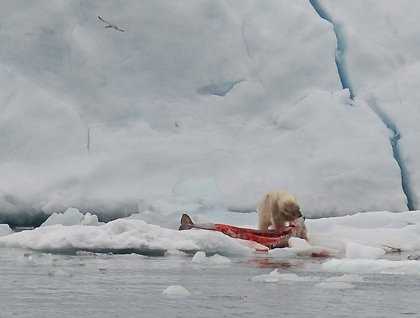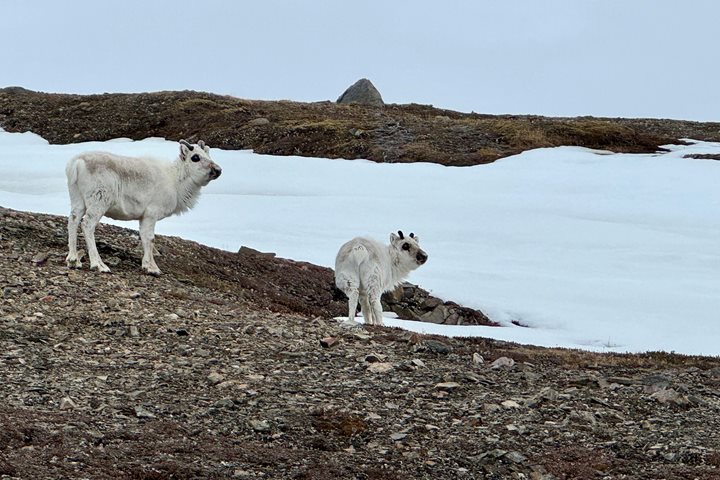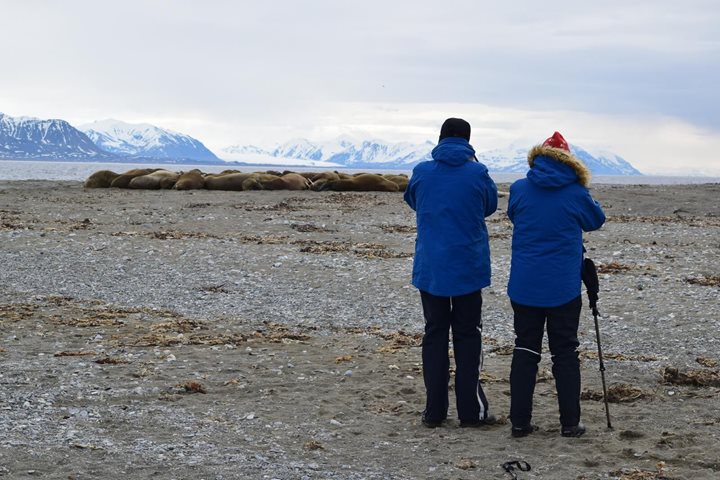Through the night National Geographic Explorer steamed south along the coast of western Spitsbergen, the main and largest island in the Svalbard Archipelago. In the early morning we ventured into the southernmost fjord, Hornsund. We were surrounded by high peaks, with Hornsundtind 1431meters high, and large glaciers falling into the sea – a mighty alpine landscape. Our “hunt” was on and most guests had not even made it to breakfast before the announcement came through: “POLAR BEAR!”
We approached one of the southern arms towards Samarinbreen (breen = glacier in Norwegian) and on a piece calved from the glacier front a large male polar bear was eating with frenzy. We instantly saw it had a large prey but it was not until we got closer that we fully realized it was a whale and most likely a younger beluga whale. How and when or even if the bear killed it we will never know, or maybe the whale was killed by calving glacier ice? Still, the bear had been able to master the challenge of dragging the whale out of the water, most likely double its weight. We were also able to see how the bear had eaten mainly the blubber.
Time at last for breakfast; while the ship moved deeper into Hornsund and before most had even finished their breakfast it was time to bundle up again. Edgar, one of our able-bodied seamen, had from the bridge spotted a large ice bear on some remains of fast ice in front of the glacier. Slowly we took the ship closer and watched the bear stroll around, probably sniffing into blow holes recently used by the ringed seal. Now as we are really in to summer the fast shore ice is melting away quickly and even a polar bear had some problems to make its way. The ice is saturated with water and in a few days it will be gone in this fjord.
The fast ice around Svalbard is important for the ringed seal from March through May. They are the main prey for the polar bear. The seals give birth in snow caves, and this is a heyday for the polar bears. Now with the fast ice and seals gone, the polar bear has to survive a harsh summer, while most other mammals and birds are using this the summer to build up stores to survive the harsh winter. Yes, polar bears are really developed to survive the extreme environment we have in the High Arctic.
After the lunch it was time to step outside on terra firma and our landing was set for Gåshamna, on the southern side of the entrance to Hornsund. Soon the fleet of Zodiacs were shuttling everybody ashore, for long, medium and short hikes with plenty of photo options. This is a major historical site as it was here the English whalers establish their land-based whaling, a shore station, and still today blubber ovens and whale skeletons can be seen. The whaling for the Greenland whale (bowhead) lasted from about 1610 to 1700 until the area was hunted out. Next to arrive in Svalbard were Pomor hunters, mainly searching for walrus. They came from the White Sea. By 1850 they vanished from the area mainly because of a decree set by the Tsar to go east into Siberia and open up this huge area. Next the Norwegian trappers and sealers arrived to Svalbard. Remains of an old trapper’s cabin are still standing.
Gåshamna is also one of the early sites for important scientific stations. Over the years 1898-1904 the Swedish-Russian Arc-of-Meridian Expedition had its camp set here. Their aim was to confirm Isaac Newton’s statement about the earth being flatter towards the poles because of its spin, stated in one of the most important books ever published, “Principia.”
The base line used was from Sørkapp, the southern tip of Spitsberegn and measured by the Russians, and the northern tip at the northernmost cape of Sjuøarna (north of Nordaustlandet). It took the two groups four years to make the measurements step by step and meet halfway, only to confirm Newton, of course, was correct.
The evening ended after a great start of an expedition into the High Arctic with the Captain’s welcome cocktail and dinner. We are on the go to explore more and in the High Arctic it is patience, flexibility and opportunism which will lead our voyage.







